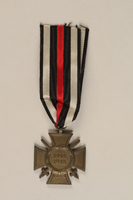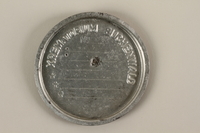Overview
- Brief Narrative
- The Iron Cross was awarded to Walter Joseph, a German Jew, for his military service in World War I.
- Date
-
commemoration:
1914-1918
- Geography
-
creation:
Berlin (Germany)
- Credit Line
- United States Holocaust Memorial Museum Collection, Gift of Bernard Feingold
- Markings
- front, center, embossed : W
front, bottom, embossed : 1914
reverse, top, embossed : FW
reverse, bottom, embossed : 1813
suspension ring, maker’s mark, engraved : KO - Contributor
-
Subject:
Walter Joseph
Manufacturer: Konigliches Munzamt Orden
Physical Details
- Classification
-
Military Insignia
- Category
-
Medals
- Object Type
-
Medals, German (lcsh)
- Physical Description
- Black painted metal alloy cross pattee style medal with a silver colored reeded border on the front and reverse. The front is embossed with an imperial crown in the top arm; a W cipher for King Wilhelm II in the center; and the year the award was reinstituted, 1914, in the bottom arm. The reverse is embossed with the FW cipher for King Friedrich Wilhelm III in the top arm; a cluster of 3 oak leaves in the center, and the year of first issue, 1813, in the bottom arm. There is a loop on the top arm with a suspension ring. The maker’s mark, KO, for Konigliches Munzamt Orden, the Royal Mint in Berlin, is engraved on the suspension ring. The medal is attached to a black with two thin white bands grosgrain ribbon.
- Dimensions
- overall: Height: 7.190 inches (18.263 cm) | Width: 1.690 inches (4.293 cm) | Depth: 0.120 inches (0.305 cm)
- Materials
- overall : iron, silver, paint, ribbon
Rights & Restrictions
- Conditions on Access
- No restrictions on access
- Conditions on Use
- No restrictions on use
Keywords & Subjects
- Topical Term
- Jewish soldiers--Germany. World War, 1914-1918--Participation, Jewish. Military decorations--Germany.
- Personal Name
- Joseph, Walter.
Administrative Notes
- Legal Status
- Permanent Collection
- Provenance
- The WWI Iron Cross medal was donated to the United States Holocaust Memorial Museum in 1989 by Brigadier General Bernard Feingold.
- Record last modified:
- 2023-08-31 14:22:06
- This page:
- https://collections.ushmm.org/search/catalog/irn522003
Download & Licensing
In-Person Research
- By Appointment
- Request 21 Days in Advance of Visit
- Plan a Research Visit
- Request to See This Object
Contact Us
Also in Bernard Feingold collection
The collection consists of artifacts relating to the experiences of Brigadier General Bernard Feingold during World War II.
Date: 1914-1941

Armband
Object

Deutscher Volkssturm Wehrmacht armband
Object
Deutscher Volkssturm Wehrmacht [German People’s Militia] brassard. This militia was not part of the army, but was organized late in the war by the Nazi Party per Hitler's orders of September 25, 1944. It was composed of males who had been exempted from home guard and military service because of age or health.

WWI Iron Cross 2nd Class medal awarded to a Jewish veteran
Object
The Iron Cross was awarded to Walter Joseph, a German Jew, for his military service in World War I.

WWI Hindenburg Cross Medal awarded to a German Jewish veteran
Object
The Hindenburg Cross (a.ka., German Cross of Honor) was awarded to Walter Joseph, a German Jew, for his military service in World War I.

Honor Cross of the World War 1914/1918 combatant veteran service medal awarded to a German Jewish veteran
Object
Das Ehrenkreuz des Weltkriegs 1914 1918 [The Honor Cross of World War 1914/1918) awarded for serving in combat in the German Army during the First World War. The award was established by President Paul von Hindenburg, on July 13, 1934. This was the first official WWI service medal of the Third Reich, often referred to by an unofficial name, Hindenburg Cross. Hindenburg, Field Marshal of German forces during WWI, appointed Hitler as Chancellor in January 1933, and soon a Nazi dictatorship ruled the country.
Buchenwald Standort-Kantine concentration camp scrip, 2 Reichsmark, given to and inscribed by a US soldier
Object
2 Reichsmark Buchenwald Kantine coupon given to Bernard Feingold, a US soldier, by a Russian Jewish inmate in exchange for two cigarettes. Feingold inscribed the note with story of its receipt. In early April 1945, as US forces approached Buchenwald concentration camp, the German guards began to evacuate the camp. On April 11, the prisoners revolted and seized control of the camp. Later that day, soldiers from the Sixth Army Armored Division, part of the Third Army, arrived in camp and discovered more than 21,000 starved and ill inmates.
Theresienstadt ghetto-labor camp scrip, 100 kronen note
Object
Scrip, valued at 100 kronen, issued in the Theresienstadt (Terezin) ghetto-labor camp in 1943. All currency was confiscated from deportees upon entry and replaced with scrip and ration coupons that could be exchanged only in the camp. The Theresienstadt camp existed for 3.5 years, from November 24, 1941 to May 9, 1945. It was located in a region of Czechoslovakia occupied by Germany, renamed the Protectorate of Bohemia and Moravia, and made part of the Greater German Reich.
Theresienstadt ghetto-labor camp scrip, 50 kronen note
Object
Scrip, valued at 50 kronen, issued in the Theresienstadt (Terezin) ghetto-labor camp in 1943. All currency was confiscated from deportees upon entry and replaced with scrip and ration coupons that could be exchanged only in the camp. The Theresienstadt camp existed for 3.5 years, from November 24, 1941 to May 9, 1945. It was located in a region of Czechoslovakia occupied by Germany, renamed the Protectorate of Bohemia and Moravia, and made part of the Greater German Reich.
Theresienstadt ghetto-labor camp scrip, 20 kronen note
Object
Scrip, valued at 20 kronen, issued in the Theresienstadt (Terezin) ghetto-labor camp in 1943. All currency was confiscated from deportees upon entry and replaced with scrip and ration coupons that could be exchanged only in the camp. The Theresienstadt camp existed for 3.5 years, from November 24, 1941 to May 9, 1945. It was located in a region of Czechoslovakia occupied by Germany, renamed the Protectorate of Bohemia and Moravia, and made part of the Greater German Reich.
Theresienstadt ghetto-labor camp scrip, 10 kronen note
Object
Scrip, valued at 10 kronen, issued in the Theresienstadt (Terezin) ghetto-labor camp in 1943. All currency was confiscated from deportees upon entry and replaced with scrip and ration coupons that could be exchanged only in the camp. The Theresienstadt camp existed for 3.5 years, from November 24, 1941 to May 9, 1945. It was located in a region of Czechoslovakia occupied by Germany, renamed the Protectorate of Bohemia and Moravia, and made part of the Greater German Reich.
Theresienstadt ghetto-labor camp scrip, 5 kronen note
Object
Scrip, valued at 5 kronen, issued in the Theresienstadt (Terezin) ghetto-labor camp in 1943. All currency was confiscated from deportees upon entry and replaced with scrip and ration coupons that could be exchanged only in the camp. The Theresienstadt camp existed for 3.5 years, from November 24, 1941 to May 9, 1945. It was located in a region of Czechoslovakia occupied by Germany, renamed the Protectorate of Bohemia and Moravia, and made part of the Greater German Reich.
Theresienstadt ghetto-labor camp scrip, 2 kronen note
Object
Scrip, valued at 2 kronen, issued in the Theresienstadt (Terezin) ghetto-labor camp in 1943. All currency was confiscated from deportees upon entry and replaced with scrip and ration coupons that could be exchanged only in the camp. The Theresienstadt camp existed for 3.5 years, from November 24, 1941 to May 9, 1945. It was located in a region of Czechoslovakia occupied by Germany, renamed the Protectorate of Bohemia and Moravia, and made part of the Greater German Reich.
Theresienstadt ghetto-labor camp scrip, 1 krone note
Object
Scrip, valued at 1 krone, issued in the Theresienstadt (Terezin) ghetto-labor camp in 1943. All currency was confiscated from deportees upon entry and replaced with scrip and ration coupons that could be exchanged only in the camp. The Theresienstadt camp existed for 3.5 years, from November 24, 1941 to May 9, 1945. It was located in a region of Czechoslovakia occupied by Germany, renamed the Protectorate of Bohemia and Moravia, and made part of the Greater German Reich.





